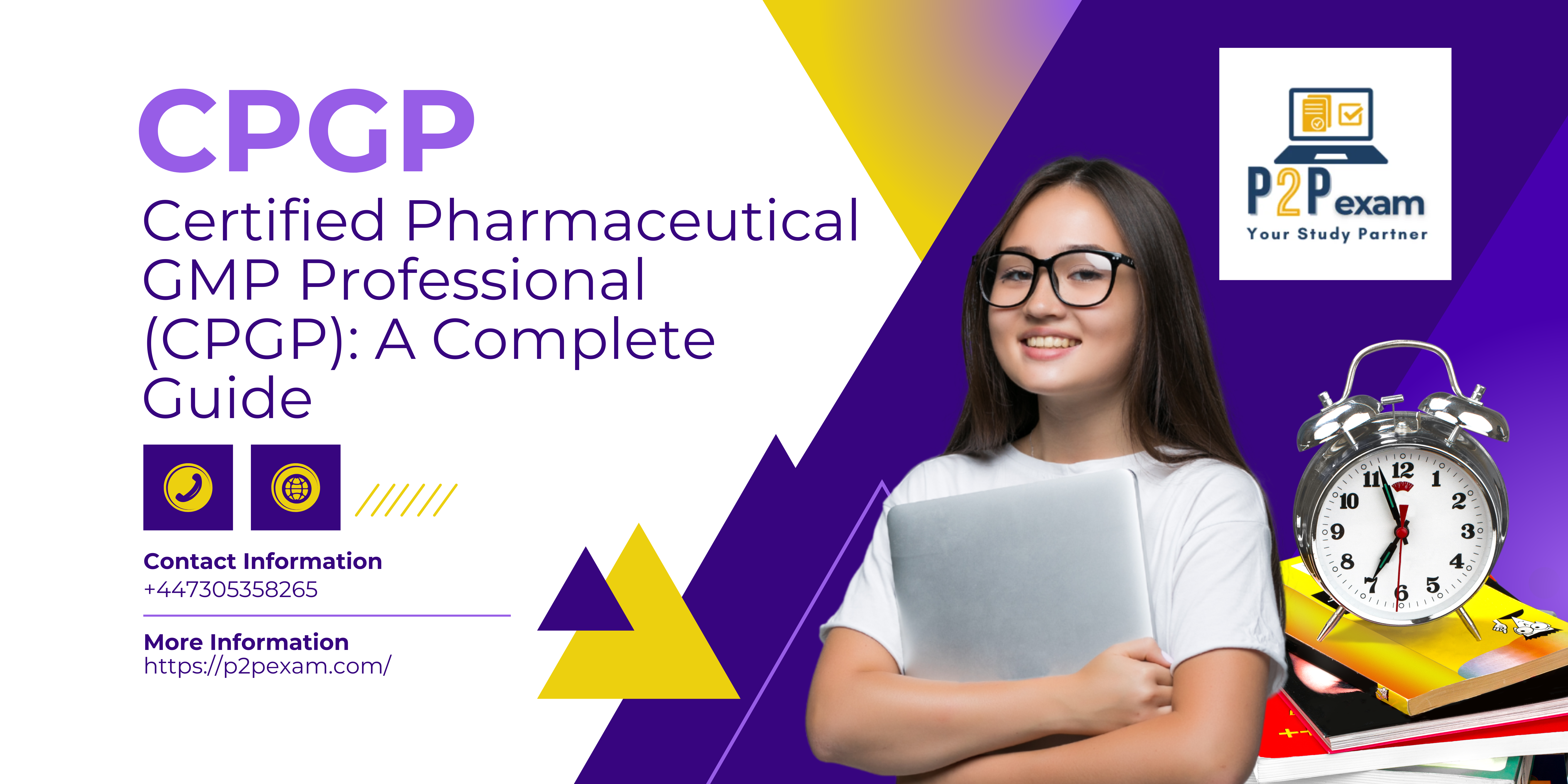Certified Pharmaceutical GMP Professional (CPGP): A Complete Guide

Strong 8k brings an ultra-HD IPTV experience to your living room and your pocket.
To guarantee the efficacy, safety, and quality of medications and medical supplies, the pharmaceutical industry is subject to stringent regulatory oversight. Businesses must adhere to Good Manufacturing Practices (GMP) in order to produce goods that live up to these exacting standards. The American Society for Quality (ASQ) offers the Certified Pharmaceutical GMP Professional (CPGP) certification, which is a respected qualification that attests to the skills and knowledge of professionals operating in GMP-regulated settings.
The goal, eligibility, exam format, domains covered, study advice, and advantages of the CPGP certification are all thoroughly covered in this article.
What is the CPGP Certification?
The CPGP certification is intended for people who comprehend and implement GMP guidelines in the pharmaceutical sector. It exhibits expertise in industry procedures and regulatory requirements at every stage of the product lifecycle, from production and handling of raw materials to packaging, labelling, and distribution.
A professional's ability to support and improve GMP compliance, create and improve quality systems, and manage risk in manufacturing environments is reflected in their certification.
Who Should Pursue CPGP?
The CPGP certification is ideal for professionals involved in the following areas:
• Pharmaceutical manufacturing
• Quality assurance and quality control
• Regulatory compliance
• Laboratory operations
• Supplier and material management
• Validation and process control
• GMP auditing and inspections
Job titles that commonly align with this certification include:
• Quality Assurance Specialist
• GMP Compliance Officer
• Regulatory Affairs Manager
• Validation Engineer
• Manufacturing Supervisor
• Quality Control Analyst
• Quality Systems Manager
CPGP can improve your professional credibility in the life sciences industry, regardless of your goals: advancing your career, moving into a compliance-focused role, or confirming your experience.
Exam Overview
The American Society for Quality (ASQ) administers the CPGP exam, which can be taken on paper or on a computer.
• Number of Questions: 165 (150 scored, 15 unscored)
• Exam Duration: 5 hours
• Type of Questions: Multiple-choice
• Language: English
• Delivery: Prometric test centers or ASQ-proctored paper-based locations
Candidates must have worked in a pharmaceutical setting subject to GMP regulations for at least five years in order to be eligible for the test. One year must be spent in a position that involves making decisions. Part of the experience requirement may be met by a degree:
• Diploma: Reduces one year
• Associate degree: Reduces two years
• Bachelor’s degree: Reduces four years
• Master’s/Doctorate: Still requires one year in a decision-making position
CPGP Body of Knowledge (BoK)
The exam is structured around the following key domains:
1. GMP Regulations and Guidelines
This section evaluates understanding of global regulatory frameworks that control the production of pharmaceuticals, such as:
• U.S. FDA 21 CFR Parts 210 and 211
• ICH guidelines (Q7 to Q10)
• WHO GMP requirements
• EU regulations and PIC/S standards
The similarities, differences, and worldwide ramifications of different regulatory bodies must be understood by candidates.
2. Quality Systems
This domain includes:
• Quality management systems (QMS)
• Deviation handling
• Corrective and preventive actions (CAPA)
• Change control procedures
• Audit planning, execution, and follow-up
• Management reviews and continuous improvement processes
3. Laboratory Systems
Key topics include:
• Laboratory equipment calibration and qualification
• Method validation
• Handling out-of-specification (OOS) results
• Analytical testing
• Data integrity and documentation requirements
• Laboratory controls and standard operating procedures
4. Equipment and Facilities
This section focuses on:
• Facility design and layout for GMP compliance
• Cleanroom classifications and environmental controls
• HVAC systems and utilities (water, compressed gases, steam)
• Equipment maintenance, calibration, and validation
• Equipment qualification (IQ, OQ, PQ)
5. Materials and Supply Chain Management
Areas covered include:
• Supplier qualification and monitoring
• Raw material handling and sampling
• Material testing and release
• Quarantine and inventory control
• Traceability, reconciliation, and storage requirements
6. Production Systems
Candidates must understand:
• Batch record creation and review
• Manufacturing instructions and procedures
• In-process controls and critical quality attributes
• Process validation (prospective, concurrent, retrospective)
• GMP practices in aseptic, sterile, and non-sterile manufacturing
7. Packaging and Labeling
Key topics include:
• Label creation, review, and control
• Packaging line clearance and reconciliation
• Serialization and tamper-evident features
• Final product inspection
• Documentation of packaging operations
8. Risk Management
This domain tests the understanding of:
• ICH Q9 guidelines
• Risk assessment techniques (e.g., FMEA, HACCP, risk matrices)
• Risk mitigation and control strategies
• Application of risk-based approaches in decision-making
How to Prepare for the CPGP Exam
To succeed on the CPGP exam, one must prepare well. The following techniques can assist candidates in efficiently preparing:
1. Review the ASQ Body of Knowledge (BoK):
Download the official BoK from the ASQ website and study each domain thoroughly.
2. Study Regulatory Guidelines:
Familiarize yourself with critical documents such as FDA’s 21 CFR Parts 210/211 and ICH guidelines. Understanding regulatory intent and implementation practices is crucial.
3. Read Reference Books:
Recommended titles include:
o Good Manufacturing Practices for Pharmaceuticals by Joseph D. Nally
o Pharmaceutical Quality Assurance by R. W. Jenkins
4. Take Training Courses:
ASQ and other professional organizations offer training programs and bootcamps for the CPGP exam.
5. Use Practice Tests:
Practice questions help reinforce concepts and improve time management. Identify weak areas and revisit them systematically.
6. Join Study Groups:
Engaging with peers through online forums, LinkedIn groups, or local quality chapters can provide motivation, tips, and clarification of complex topics.
Benefits of CPGP Certification
The CPGP credential provides several career and personal development advantages:
• Professional Recognition: Demonstrates your expertise and commitment to GMP compliance.
• Career Advancement: Opens doors to roles in QA, compliance, and regulatory leadership.
• Competitive Edge: Distinguishes you in a crowded job market.
• Global Credibility: Recognized by employers across the pharmaceutical, biotechnology, and medical device industries.
• Continuous Learning: Encourages staying up to date with regulatory changes and industry best practices.
Maintaining the CPGP Certification
CPGP certification is valid for three years. To maintain it, professionals must:
• Earn recertification units (RUs) through training, conferences, work experience, or publishing
• Submit an application and fee to ASQ before the expiration date
Recertification guarantees that certified professionals maintain their expertise and carry on making valuable contributions to GMP compliance.
For practice questions, study guides, and preparation materials, visit:
CPGP
Note: IndiBlogHub features both user-submitted and editorial content. We do not verify third-party contributions. Read our Disclaimer and Privacy Policyfor details.



